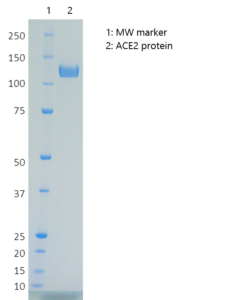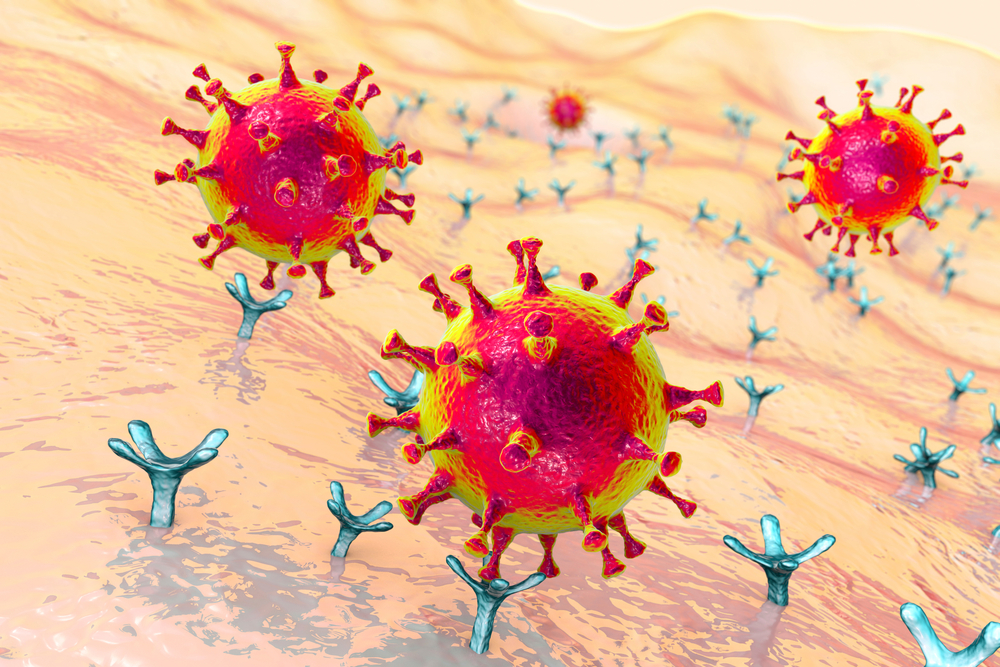
SDS-PAGE: ACE2 protein run on a reducing SDS-PAGE showing greater than 98% purity.
Human ACE2 (18-615) Recombinant Protein, Sheep Fc-Tag (HEK293)
Price range: $781.96 through $2,968.09 excl. VAT
Recombinant human angiotensin-converting enzyme 2 (ACE2) extracellular domain (18-615) was expressed in HEK293 cells using a C-terminal sheep Fc-tag and purified to SARS-CoV-2 receptor binding domain (RBD) of the spike protein binds to the host cell ACE2 receptor to facilitate viral entry into the cell. SARS-CoV-2, previously known as the 2019 Novel Coronavirus (2019-nCoV), causes the pandemic COVID-19 disease.
HUMAN ACE2 (18-615) RECOMBINANT PROTEIN, SHEEP FC-TAG (HEK293)
Recombinant human angiotensin-converting enzyme 2 (ACE2) extracellular domain (18-615) was expressed in HEK293 cells using a C-terminal sheep Fc-tag.
PRODUCT DETAILS – HUMAN ACE2 (18-615) RECOMBINANT PROTEIN, SHEEP FC-TAG (HEK293)
- Recombinant human angiotensin-converting enzyme 2 (ACE2) (NCBI: 6M17_B).
- Protein was C-terminally truncated to remove both the ADAM17 and TMPRSS2 cleavage sites.
- Human ACE2 was produced in HEK293 cells by transient transfection with C-term sheep Fc-tag.
- Purified from culture supernatant by Protein G chromatography to greater than 98% purity and presented in DPBS.
- Biotinylated ACE2 can be used as a detection reagent in a binding assay (ELISA) with SARS-CoV-2 full-length spike (REC31868), spike subunit 1 (S1) (REC31806) and RBD (REC31882), at a concentration between 0.1-1.0 µg/ml.
BACKGROUND
Angiotensin converting enzyme 2 (ACE2) or ACE homologue (ACEH) was discovered as a zinc metalloproteinase by two different groups in 2000 (Patel et al., 2016). ACE2 is an enzyme attached to the cell membranes in lungs, arteries, heart, kidney, and intestines. It is a type I transmembrane protein with an extracellular N-terminal domain containing the catalytic site and an intracellular C-terminal tail. The protein contains a signal peptide, a transmembrane domain, and a single metalloproteinase active site containing an HEXXH zinc-binding domain. The extracellular domain of ACE2 is cleaved from the transmembrane domain by an enzyme known as sheddase, and the resulting soluble protein is released into the blood stream and ultimately excreted into urine. ACE2 acts as a mono-carboxypeptidase (removing a single amino acid) that degrades Ang I to generate the nonapeptide Ang 1–9 and Ang II to generate the heptapeptide Ang 1–7. Expression of a soluble truncated form of ACE2 in CHO cells produced a glycoprotein of 120 kDa that was able to cleave Ang I and II but not bradykinin and ACE2 catalytic efficiency is 400-fold higher with Ang II as a substrate than with Ang I.
It has been reported that human ACE2 is also the entry receptor of SARS coronaviruses (Li et al., 2003), including SARS-CoV-2, and that a serine protease is important for SARS-CoV-2 Spike activation (Hoffmann et al., 2020). The coronavirus spike (S) glycoprotein is a class I viral fusion protein on the outer envelope of the virion that plays a critical role in viral infection by recognizing host cell receptors and mediating fusion of the viral and cellular membranes (Li, 2016). Two major domains in coronavirus S1 have been identified, the N-terminal domain (S1-NTD) and C-terminal domain (S1-CTD). Either or both of these S1 domains can function as a receptor-binding domain (RBD), depending on virus; SARS-CoV and MERS-CoV both use C-domain to bind their receptors (Ou et al., 2020). While S proteins of SARS-CoV-2 share about 76% amino acid identities with SARS-CoV, the amino acid sequence of potential RBD of SARS-CoV-2 is only about 74% homologous to that of SARS-CoV. It has been hypothesized that decreasing the levels of ACE2 in cells may give some protective effects against infection. ACE2 has been shown to have a protective effect against virus-induced lung injury by increasing the production of the vasodilator angiotensin 1–7 (Imai et al., 2008).
REFERENCES
- Hoffmann M, Kleine-Weber H, Schroeder S, et al. (2020). SARS-CoV-2 Cell Entry Depends on ACE2 and TMPRSS2 and Is Blocked by a Clinically Proven Protease Inhibitor. Cell. 2020;S0092-8674(20)30229-4.
- Imai Y, Kuba K, Penninger JM. (2008). The discovery of angiotensin-converting enzyme 2 and its role in acute lung injury in mice. Exp Physiol. 2008;93(5):543–548.
- Li F. (2016). Structure, Function, and Evolution of Coronavirus Spike Proteins. Annu Rev Virol. 2016;3(1):237–261.
- Li W, Moore MJ, Vasilieva N, Sui J, Wong SK, Berne MA, Somasundaran M, Sullivan JL, Luzuriaga K, Greenough TC, Choe H, Farzan M. (2003). Angiotensin-converting enzyme 2 is a functional receptor for the SARS coronavirus. Nature. 2003 Nov 27; 426(6965):450-4.
- Ou X, Liu Y, Lei X, et al. (2020). Characterization of spike glycoprotein of SARS-CoV-2 on virus entry and its immune cross-reactivity with SARS-CoV. Nat Commun. 2020;11(1):1620.
- Patel VB, Zhong JC, Grant MB, Oudit GY. (2016). Role of the ACE2/Angiotensin 1-7 Axis of the Renin-Angiotensin System in Heart Failure. Circ Res. 2016;118(8):1313–1326.
- Novel coronavirus (2019-nCoV), World health Organisation (WHO), 2020.

